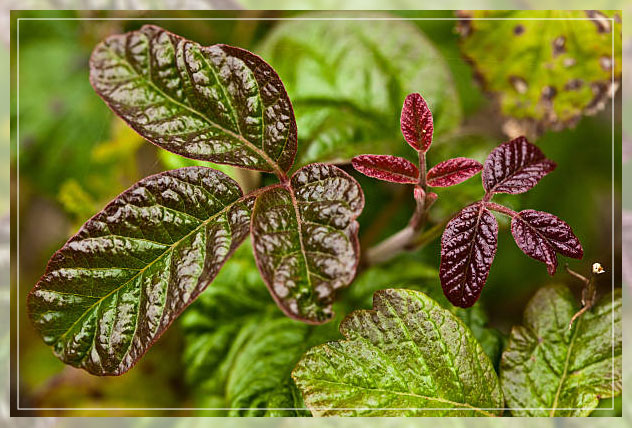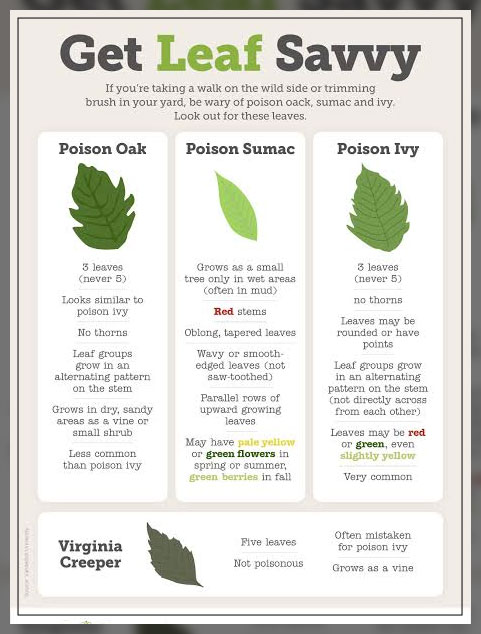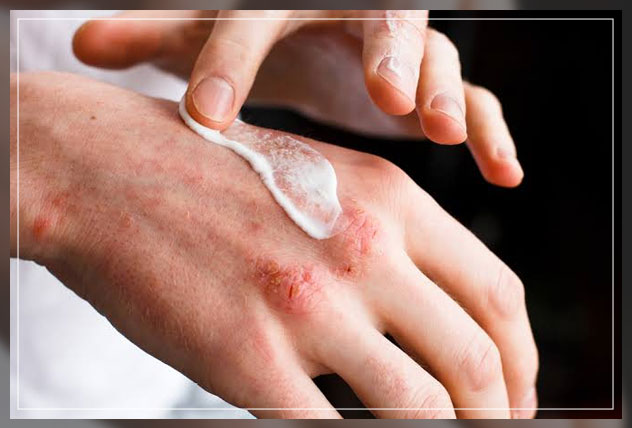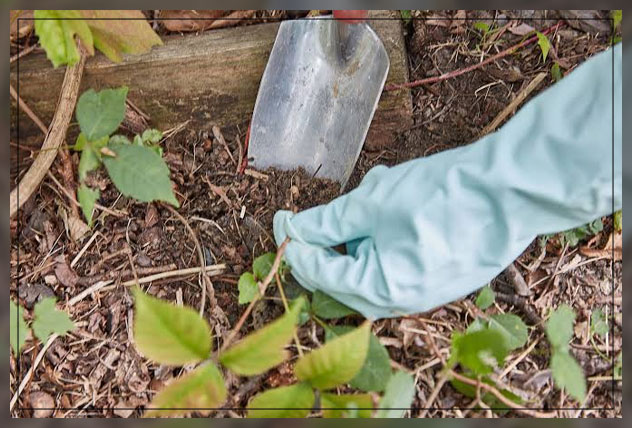Do you know that poison oak is one of the poisonous plants that can cause a rash when you come in contact with it?
Poison oak or Toxicodendron diversilobumis not an oak plant, however, a low-growing deciduous shrub.
Moreover, its stems and leaves contain urushiol, natural oil that tends to cause a severe skin rash at any time of the year.
It can even cause a rash in winter when the shrub has no leaves on it.
This plant is native to North America and as such has significant wildlife value.
Birds like robins who like barriers, and songbirds feed on the berries of this plant during migration.
While other birds feed on the insects that live on poison oak.
However, when poison oak pops up in your yard, you will need to protect yourself from its dangers.
After proper identification, you should make sure to safely remove this plant.
Therefore, familiarizing yourself with poison oak can help to identify it not only in your yard but also in the wild.
Keep on reading.
Poison Oak Gardening Considerations
If this plant pops up in your yard, it is most likely to be there by the birds who eat berries.
The plant that is visible to the eye grows slowly. However, poison oak tends to develop a large underground root system.
This is because it is dangerous to humans.

Therefore, it is crucial to identify and remove it as soon as possible it pops up.
| Botanical Name | Toxicodendron diversilobum |
| Common Name | Poison oak, western poison oak, Pacific poison oak |
| Plant Type | Perennial |
| Mature Size | Three to six feet height |
| Bloom Time | Spring |
| Flower Color | White-greenish |
| Toxicity | Toxic to humans if touched |
Learn more about Poisonous Plants: An Overview here.
Identifying Poison Oak
Poison oak belongs to the same genus as poison ivy and poison sumac.
Moreover, it tends to have similar botanical characteristics.
Just like poison ivy, a single leaf of this plant consists of three leaflets or three-parted leaves.
Moreover, the stem of the center leaflet is longer than the stem of the leaflets on either side.
However, not all leaves are equally lobed. When they are, they will resemble oak leaves which gives the plant its common name.
The size of the leaves tends to vary even on the same plant. The average length is about six inches.

The new leaves in the spring will be reddish, and because of the oil they have, the leaves appear shiny.
Later the leaves will turn green.
Furthermore, in the fall, before they fall, they tend to drop and turn into different shades of red and yellow.
Both the stems and leaflets of poison oak are covered with fine hairs.
The clusters of poison oak and poison sumac of small, white-greenish flowers in the late spring turn into small, waxy, greenish-yellow, or white berries in the late summer.
These berries will often remain on the plant through early winter.
While during dormancy, without characteristic leaves, poison oak can be more difficult to identify.
The stems will be light brown, cinnamon-colored, or grayish, with an upright growth pattern, like sticks.
Impact of Poison Oak
It is important to note that poison oak tends to thrive along roadsides and other areas where there is vegetation in uncultivated fields and on abandoned land.
it also is a problem in wood lots, Christian tree plantations, rangelands, and recreation areas.
While it tends to reduce optimal grazing area in the rangeland or pastures, the primary concern is the allergic reaction it causes in many people,
Moreover, all members of the genus Toxicodendron which includes poison ivy and poison sumac as well can cause allergic contact dermatitis in humans.
This allergy occurs due to the plant oil: urushiol.
It does not appear to cause allergic reactions in cats or dogs, however.
This is because their coats tend to protect them from this oil, so it is uncommon for your pet to have a reaction to it.
However, an allergic reaction may occur in areas where there is no hair or in hairless breeds with more skin exposure.
For instance, in California, the working hours lost as a result of dermatitis from poison oak makes it the most hazardous plant in the state.
Approximately about 50 to 70% of the adult population is sensitive to urushiol.
While in large urban areas, where this plant is less common, the prevalence is close to 20%.
Coming in contact with poison oak does not mean a sensitive person will get a rash.
Urushiol is present in stems, roots, leave,s and skin of the fruits of this plant.
Often damage is required for the plant to release the oil, therefore, a little contact with an injured leaf is innocuous.
While more vigorous activities like weed eating, clearing bushes, pruning, or trampling can cause injury and transfer the oil onto the skin, clothing, garden tools, or pets.
Another important thing to understand is urushiol is nonvolatile, will dry quickly, and can also persist on objects.
Thus, it retains its ability to cause an allergic reaction for months or even years.
This means that your tools, clothing, vehicle, and other objects that come in contact with this plant can continue to spread the oil.
When you burn poison oak, the oil can disperse via smoke particles, and breathing this smoke can cause severe respiratory irritation.
In fall, leaves will turn red and enriched with urushiol which can result in higher levels of exposure.
Moreover, during winters, the leaves become dry and fall off, and the oil will be reabsorbed into the stems, which makes the leaves nonallergic.
However, bare leaves in the winter can result in contact and if there is damage to the stems, oil can release, resulting in an exposure.
Tips for Treating an Allergic Reaction
Within 1 to 6 days after exposure, skin irritation and itching can occur along with water blisters.
It is important to note some people are of the view that the serum in the blisters may contain urushiol, however, it does not, and the rash does not transmit from one person to another.
However, it is important to note that the appearance of the rash may vary from one person to another.
Contact with latent oil is the reason why new rashes can develop.
The most common culprits are fingernails, clothing tools, and pets.
Dermatitis rarely lasts for more than 10 days. Make sure to avoid scratching the blisters.
This is because bacteria from under your fingernails can get into the wounds and cause an infection.

The rash, blisters, and itch normally disappear within 1 to 2 weeks without any treatment.
However, to relieve an itch, you can:
- use a wet compress or soak in cool water
- wear long sleeved shirt and use rubbing alcohol
- apply over-the-counter, OTC topical corticosteroids preparations or take prescription oral corticosteroids
- apply topical OTC skin products like aluminum acetate, zinc acetate, zinc carbonate, zinc oxide, and calamine to dry the oozing and weeping of poison ivy, poison oak, and poison sumac.
- certain protectants like baking soda or colloidal oatmeal can help relieve minor irritation and itching
- aluminum acetate is an astringent that helps relieve rash
-
dry the counter OTC topical corticosteroid preparations or taking prescription oral corticosteroids
It is important to see a doctor or seek medical advice if:
- you have a fever over 100°F,
- there is pus, soft yellow scabs, or tenderness on the rash, itching gets worsens or keeps you awake at night,
- the rash spreads to your eyes, mouth, and genital area, or covers more than one-fourth of your skin,
- the rash does not improve within a few weeks,
- you have an unknown serve reaction,
- have difficulty breathing.
Management Techniques
The primary goal of managing poison oak is mechanical removal by hand pulling, which is not recommended for individuals who are sensitive to this plant and treatment with herbicides.
However, biological control is not an option in the case of native species, in the United States.
In most areas, poison oak is not a pest, but rather a natural component of the plant community.
Avoid burning this plant as it can create a serious health hazard and does not reduce infestations.
Moreover, grazing sheep and goats can be effective in small areas. while deers, horses, and cattle can also graze poison oak when the foliage is young before the plant grows flowers.
Manual Removal of Poison Oak
You can practice manual removal of poison oak at any time of the year, except during winter in cold climates when the ground is frozen.
While methods that involve the use of herbicides are best during the height of the growing season.
Manual eradication may have to be repeated again.
The simplest method of getting rid of poison oak manually is to pull it out by the root.
Make sure that you dispose of all parts of the plant.
While another manual method for getting rid of poison oak if it is growing on the ground rather than on trees is to choke it out by covering it with impervious material.
For this, first cut the plants down close to the ground and then cover the stump with a plastic tarp, or other material that is impervious to light and water.

Then weigh down the tarp along the edges with the help of stones, bricks, or boards
If you need, however, multiple tarps, cover the plants, overlap the tarps by at least 12 inches, and weigh them down along the seam.
Though, any other plant that you cover with a tarp will also die, make sure to be careful to not kill wanted plants.
Leave the tarp in place until the plant dies, then dig up the plant, and dispose of them in plastic bags.
Remember to not burn them or compost them.
Removal with Herbicide
Two types of herbicides including glyphosate and triclopyr are effective in killing poison oak.
You can apply herbicide to the stumps of cut plants or to the foliage of uncut plants, however, you should do this while the plant is still actively growing.
For the first method, cut the stem one to two inches above the ground and apply the herbicide immediately using a spray tank.
Th fresh wound will drink the herbicide and transport it deep inside where it can do its damage.
Moreover, applying herbicides to the leaves of this plant tends to be most effective during the flowering and fruit stages of growth.
You can use glyphosate during flowering and fruit stages or a full leaf growth stage, use triclopyr.
Make sure to repeat the spray until the poison oak is fully eradicated.
Follow the steps below for the best results:
- do not spray on a gusty day, not only will you waste herbicide, but you will also risk having the spray blow onto the landscape plants and damage them
- spray only when the plant is dry and when there is no rain predication for at least 24 hours
- herbicides work best when the plants tend to be thirsty
- do not spray poison oak that is scaling a tree, as you can damage the tree
Manual removal is preferable in the above cases.
Though you can dab a bit of herbicide onto the individual leaves of the poison oak to control the application more carefully.






Leave a Reply